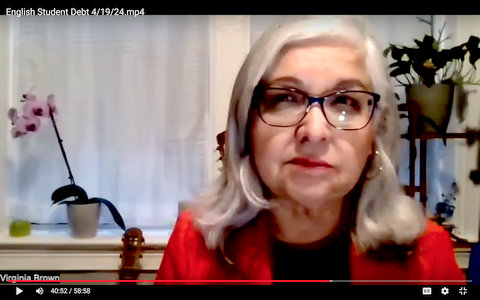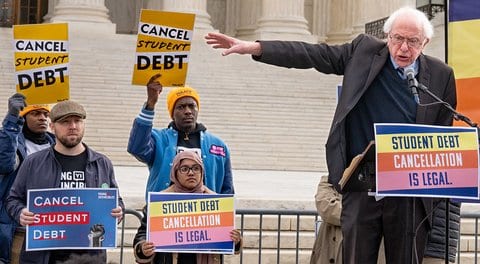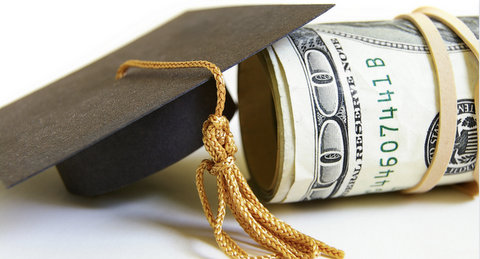
19 May Student Loans or Living Expenses? Biden Administration Tries to Ease Debt Burden

Virginia Brown ended up with $100,000 of student debt, partly because “the interest kept growing and growing and growing.” (Screenshot captured by Danielle Parenteau-Decker / The CC Pulse)
By Danielle Parenteau-Decker
Virginia Brown was a doctor and U.S. citizen who spoke English when she moved here from Venezuela in 1990 but couldn’t get work in her field. So, like many immigrants, she got whatever work she could, cleaning offices and watching children.
She wanted to do more, so she decided to go back to school. But that meant going into debt.
“My only choice was to take a loan,” Brown, 72, said at an April 19 Ethnic Media Services press briefing. “People thought I was crazy — I was going to get into all this debt, but I said, that was my only choice.”
Her degree allowed her to get work she liked helping people, but working in social services and at nonprofits, she said, the pay was low. So, at times, she had to defer making student loan payments, and “the interest kept growing and growing and growing. Even when you’re paying, it’s more interest.”
She ended up more than $100,000 in debt. Brown did not specify how much she originally took out, but because of interest, someone can easily have paid more than the amount of their loan and still be nowhere near paying off their debt.
Brown eventually had her remaining loan balance wiped out by Public Service Loan Forgiveness, in which people can have federal direct loans forgiven after they have made 120 monthly payments if they work for the government or a qualifying nonprofit.
However, “servicers have been accused of not always implementing the program correctly or adequately,” said Adam Minsky, an attorney focused on student loan law, “and the result was that through 2020, there was like a 99% rejection rate and only a few thousand borrowers had actually gotten approved for loan forgiveness.”
Consequently, the Biden administration has “implemented a number of initiatives,” according to Minsky, including new regulations that went into effect last July “that do a number of things to improve PSLF, including providing more flexibility.”
As a result, it went from about 7,000 approvals ever as of 2020 to about 900,000 through March — “just an absolute sea change,” he said.
The PSLF reforms are one of multiple ways the Biden administration is trying to ease the burden of the more than 45 million people who owe a combined $1.7 trillion in federal student debt.
Some efforts would provide relief to people “who have experienced runaway interest,” are “eligible for forgiveness under existing programs” but not enrolled, attended “low-value institutions … that might have lost eligibility for federal financial aid because of low graduation rates or poor outcomes such as not being able to line people up with good-paying jobs,” or are experiencing hardship.
“It looks like there will be several ways of demonstrating hardship whether it’s income, expenses, other debts, age, disability status, eligibility for other government programs,” he said.
In the meantime, there are targeted ways — like PSLF — in which people can have their balances partly or completely forgiven under certain circumstances. Others include Borrower Defense, “which can provide loan forgiveness for borrowers who were misled by their schools” and total and permanent disability discharge, which Minsky said was also subject to new regulations beginning last July that “again makes it easier for people to access that relief.”
If you have student debt, and you’re wondering if any of this applies to you, you are not alone.
“Borrowers are very confused about whether or not they will be receiving student loan forgiveness, what the parameters are, and who is eligible for what type of relief, what the consequences are for nonpayment or being not able to make monthly payments … and what the future holds, especially in an election year,” said Michele Shepard Zampini, senior director of college affordability at The Institute for College Access and Success.
“If the administration changes,” she said, “I think we have heard the platform from the other side is not to invest any more in students, not to invest more in student aid, not to invest more in the Pell Grant program, to cut funding… they are likely to try and overturn and put a stop to any of these debt-relief programs that are in place.”
But whether debt relief exists or not, it doesn’t address why people have so much educational debt in the first place.
“If you wipe out some student debt now,” Minsky said, “but we don’t fix the underlying problem, we’re just going to be right back where we are now in a few years.”
Part of that problem is the cost of higher education, which has gotten more expensive and “shifted on to the backs of the family,” said Shepard Zampini.
“For a number of reasons,” she continued, “we are now asking students and their families to cover a much higher percentage of those costs than ever before while at the same time because of many of the same factors those costs have increased significantly.”
Many people can’t afford those costs upfront, so without loans, she said, “many students would not be able to go to college at all, but it has become a replacement for other types of funding, mostly public funding, that would enable to students to enroll without needing to borrow so much.”
Minsky acknowledged the “common criticism that it’s unfair to people that have already paid their debt” but said that shouldn’t “stop us from implementing measures and programs to help people out.”
Student loans can keep people in debt their whole lives or well into old age, and this debt worsens economic inequality along race and gender lines.
>>>Read: Student Debt Fuels Racial Wealth Gap, Advocates Say
All the while, people are “struggling to decide between basic living expenses, like covering their rent, covering their food expenses, covering childcare, healthcare, transportation — all of these necessary bills for basic living expenses are competing with their student loan bill,” Shepard Zampini said.
Income-driven repayment plans, at least, can help make that debt more manageable. One of those is the new SAVE plan, which Minsky called “by far the most affordable income-driven option” and Shepard Zampini said “has gone under the radar.”
If you have federal student debt and want to know more about your repayment or forgiveness options, contact your loan servicer or visit studentaid.gov.






No Comments